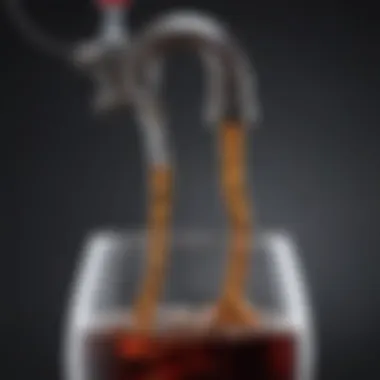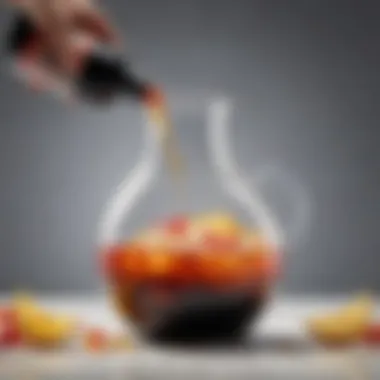Exploring the Soda Siphon: History and Culinary Uses


Intro
The soda siphon is a tool that has shaped the beverage industry and culinary practices for decades. Its rich history is interwoven with the evolution of carbonated drinks. Not only has the siphon itself transformed, but so has its perception in kitchens around the world. Understanding the soda siphon involves examining its historical context, mechanical function, and diverse uses in gastronomy.
The device operates on a simple principle. It combines water with carbon dioxide gas to produce sparkling beverages. While this process may seem straightforward, the mechanics behind the siphon reveal much about engineering and design. The article will shed light on how these mechanisms work and the innovations introduced over time.
Furthermore, practical applications are numerous. From making soda at home to using it in professional kitchens for molecular gastronomy, the soda siphon has been a vital tool for enhancing culinary creativity. This comprehensive examination aims to provide insights not only into its past but also into current trends and future potential within the culinary arts.
Preface to the Soda Siphon
The soda siphon represents a unique intersection of culinary innovation and mechanical design, serving not just as a tool for carbonating drinks but also as a gateway into gastronomic creativity. This section will outline the foundational understanding of the soda siphon, underscoring its significance in both everyday kitchens and professional culinary environments.
From sparkling water to cocktail enhancements, the soda siphon has diverse applications that elevate the sensory experience of beverages and foods alike. Given the growing trend towards homemade craft cocktails and gourmet culinary experiences, understanding this tool becomes increasingly relevant.
Definition and Basic Function
A soda siphon is a device that uses pressurized carbon dioxide to carbonate liquid. Typically composed of a durable container, a carbonation cartridge, and a dispensing mechanism, the siphon works by forcing carbon dioxide into the liquid under pressure. This process creates bubbles that enhance the texture and flavor of beverages.
When a user presses the lever on the siphon, it releases the carbonated liquid with a satisfying fizz. This immediate carbonation enables individuals to customize their sparkling water and craft cocktails to their liking. The mechanics are simple yet effective, with a focus on ease of use that appeals to both beginners and seasoned enthusiasts.
Purpose in Culinary Arts
In the realm of culinary arts, the soda siphon is more than a tool; it is an instrument of creativity. It allows chefs and home cooks to experiment with carbonation, transforming ordinary liquids into exciting, fizziness-laden concoctions. This device can help create infused sparkling waters, unique cocktails, and even foams or espumas that are commonly found in avant-garde cuisine.
- Crafting beverages: Bartenders utilize soda siphons to concoct cocktails with a refreshing effervescence.
- Innovative aesthetics: Presents dishes with stylish foams that tantalize the palate and eyes.
- Versatile applications: Beyond drinks, nutritional ingredients can be carbonated to enhance textures in savory dishes.
As we delve into the history and evolution of the soda siphon, it becomes clear that its purpose transcends mere carbonation—rather, it embodies the spirit of culinary exploration and modernization.
Historical Background
The historical background of the soda siphon is crucial to understanding its evolution and significance in the culinary world. This section provides insight into how the soda siphon transitioned from a simple tool to a vital instrument in modern kitchens, particularly in the realms of both amateur and professional cooking. By tracing its origins, evolution, and cultural impact, readers can appreciate the innovative spirit behind this appliance and its role in beverage culture.
Origins of the Soda Siphon
The soda siphon has its roots in the late 18th century. Its invention is often credited to Joseph Priestley, an English chemist who discovered a method to infuse water with carbon dioxide. However, it was not until the 1820s that the first commercial soda siphons emerged in Europe. Originally, these siphons were predominantly designed for carbonated beverages, aiding in their dispensation much like a traditional fountain.
Early designs featured a pressurized container that allowed for the release of carbonated water when the lever was pulled. This - revolutionary mechanism - facilitated the enjoyment of fizzy drinks without the need for a bar or a specialized beverage service.
Through its initial designs, the soda siphon not only quenched thirst but also laid the groundwork for modern mixology.
Evolution Over the Decades
Over the years, the soda siphon underwent significant changes in both design and functionality. By the late 19th century, devices had evolved to include stronger materials like glass and metal, allowing for better pressure retention and improved safety. The introduction of the carbonation cartridge in the early 20th century further revolutionized the soda siphon, making it more user-friendly and accessible for home use.
In the 1950s and 1960s, the popularity of the soda siphon surged again, coinciding with the rise of cocktail culture in the post-war era. Chefs and baristas began to experiment with drinks and culinary techniques that utilized carbonation in new ways. The rise of molecular gastronomy in the late 20th century brought the soda siphon back into the spotlight, as it became essential for creating foams and textures previously unattainable in traditional cooking.
Impact on Beverage Culture
The impact of the soda siphon on beverage culture cannot be overstated. This tool democratized the enjoyment of sparkling drinks, allowing individuals to create their own carbonated beverages at home. It also contributed to the cocktail renaissance, providing bartenders with a means to craft innovative drinks that incorporate fizz and texture.
Moreover, the soda siphon has become a symbol of culinary experimentation. Many renowned chefs embrace its use in modern cuisine. Its versatility extends beyond drinks; it is utilized to create foams and espumas, adding unique flavors and textures to dishes.
In summary, the soda siphon has evolved from a simple device into a multifaceted tool that impacts culinary practices. Understanding its historical context enhances the appreciation of this device and its innovative applications today.


Mechanics of the Soda Siphon
The mechanics of the soda siphon play a crucial role in understanding its functionality and versatility. This section delves into the vital components that enable the device to carbonate liquids effectively. By grasping the mechanics, users can appreciate how each part contributes to the overall efficiency and usability of the siphon.
Components of a Soda Siphon
Container
The container of a soda siphon is essential as it holds the liquid to be carbonated. Typically made from glass or stainless steel, the container must withstand high pressure generated during carbonation. The choice of material impacts safety and durability. Glass offers aesthetics and purity in flavor but is more fragile. On the contrary, stainless steel is robust, making it popular in professional settings. Its insulation properties help maintain temperature, enhancing carbonation. However, the weight can be a disadvantage for home use. Consider seriousness for your applications when selecting a container type.
Carbonation Cartridge
The carbonation cartridge is integral to achieving the desired fizz in beverages. It contains compressed CO2, which is released into the liquid when the siphon is activated. One key characteristic of the cartridge is its convenience. Each cartridge typically carbonates up to one liter of liquid, making it efficient for home or bar use. The
single-use nature of these cartridges can be a downside, as it raises concerns about waste. Yet, the easy-to-replace design ensures users can continue making sparkling drinks without interruption. The efficiency and straightforward operation make the carbonation cartridge a popular component in any siphon.
Dispensing Mechanism
The dispensing mechanism is where the user interacts with the siphon. This part allows the carbonated liquid to flow out with minimal pressure loss. The design often includes a lever or push-button system, which controls the volume and speed of the dispensing. One noteworthy feature of the dispensing mechanism is its ability to create controlled pour sizes, an advantage for cocktail creation. However, improper handling can lead to excess foaming or spillage, which might be frustrating for first-time users. Understanding this mechanism is vital for optimal performance.
How Carbonation Works
Carbonation involves the dissolution of carbon dioxide gas in a liquid. When the CO2 cartridge releases gas under pressure into the container of liquid, it forces the gas to dissolve. As the pressure is released during pouring, the dissolved gas escapes, creating bubbles. This process transforms still water or other beverages into sparkling, effervescent drinks. Knowing this allows a better understanding of how to achieve perfect carbonation at home, catering to personal taste preferences.
Safety Mechanisms
Safety mechanisms in soda siphons are crucial to prevent accidents arising from high-pressure usage. Modern siphons often include pressure release valves, which help manage excess pressure. Additionally, materials used for construction are designed to withstand pressure beyond typical usage limits. Users should always check for signs of wear and tear to prevent potential hazards. Understanding these safety features ensures a safer experience while using soda siphons.
Practical Uses in the Kitchen
Understanding the practical uses of a soda siphon adds great value to any kitchen. It is not just a tool for carbonating beverages; its versatility extends to various culinary applications. Using a soda siphon can elevate the home cooking experience by introducing unique textures and flavors into recipes. Methods such as carbonating fruit juices or crafting specialty cocktails bring creativity into cooking. The ability to make sparkling water at home also promotes freshness and quality in drinks, reducing the need for store-bought options.
Making Sparkling Water at Home
Making sparkling water at home using a soda siphon is both simple and rewarding. With a few components, anyone can transform tap water into a fizzy delight. First, fill the siphon with cold water, as chilled liquids carbonate better. Then, attach a carbonation cartridge. This small cylinder contains carbon dioxide, which is released when activated. Once the cap is secured, the carbon dioxide is injected into the water, creating carbonation. Shake gently to distribute the gas before dispensing.
The freshness of homemade sparkling water is unmatched. Control over flavorings is also possible, allowing for the addition of herbs or fruits. This results in unique, customized beverages without added sugars or preservatives. For anyone seeking healthier alternatives, this method is particularly advantageous.
Cocktail Creation
The use of a soda siphon in cocktail creation opens a realm of possibilities. It allows both amateur and professional mixologists to experiment with textures and carbonation levels. For instance, cocktails can be transformed into delightful fizzy drinks, adding a layer of complexity to classic recipes.
There are many ways to incorporate a soda siphon in this context. Ingredients such as syrups, juices, or spirits can be carbonated and served as a base for different cocktails. This enables the development of signature drinks that astonish guests. The fine bubbles created enhance the overall drinking experience by delivering flavors in a unique way.
Foams and Espumas in Modern Cuisine
Foams and espumas have become hallmark elements in modern culinary techniques. The soda siphon serves as an essential tool in creating these textures. Chefs utilize the siphon to add airy, light movements to sauces or desserts. The siphon operates by mixing liquids with gas, resulting in foamy textures that enhance visual appeal and mouthfeel.
For example, a chef might prepare a foam using fruit juice, sugar, and stabilizers. After chilling the mixture, the soda siphon is charged and dispensed. This method produces a light foam that can be used as a garnish or main component in dishes, adding depth to the flavor profile.
Incorporating foams provides not only taste but also intricate presentation techniques.
In summary, the practical applications of a soda siphon in the kitchen encourage experimentation and creativity. Whether crafting sparkling water, dynamic cocktails, or modern foams, it enhances culinary experiences. Its evolution from a simple carbonating tool to an essential kitchen device reflects the versatility needed in contemporary cooking.


Soda Siphons in the Professional Culinary Sphere
Soda siphons have carved out a significant niche within the realm of professional culinary arts. Their ability to create carbonated beverages and innovative culinary elements has made them an indispensable tool in many high-end kitchens. Renowned chefs utilize soda siphons not just for their functional capabilities, but also for the creative possibilities they afford. By understanding their role in professional settings, we gain deeper insights into both their practical benefits and artistic applications.
Adoption by Renowned Chefs
Culinary stars such as Ferran Adrià and Grant Achatz have championed the soda siphon. These chefs have embraced its capabilities, showcasing advanced techniques that elevate simple recipes to extraordinary experiences. The soda siphon allows for the infusion of flavors into liquids, creating complex profiles easily.
Moreover, many chefs appreciate the customization options this tool offers. By tweaking carbonation levels, they can adjust the texture and mouthfeel of the final product. This flexibility is vital, particularly in fine dining. Observing a chef utilize a soda siphon demonstrates the evolution from basic beverage preparation to innovative culinary expression.
Incorporation into Molecular Gastronomy
Molecular gastronomy is a movement that transforms traditional cooking methods into scientific techniques that reveal new culinary experiences. Soda siphons play a pivotal role in this transformation. They are especially effective for creating foams and gaseous infusions, which are hallmarks of molecular gastronomy.
The mechanics of carbonation facilitate unique preparations. For instance, chefs can use a soda siphon to create light and airy foams from various liquids. Such foams add visual appeal and unexpected texture to dishes. Moreover, soda siphons enable the infusion of flavors into oils and spirits, presenting a distinct tasting experience uncommon in standard cooking practices.
The integration of soda siphons in molecular gastronomy highlights a fascinating intersection of science and art, pushing culinary boundaries further than ever.
The continual exploration of these tools leads to novel discoveries in flavor combinations and presentation techniques. As more chefs innovate with soda siphons, we are likely to see an ongoing evolution in the culinary landscape.
Comparison to Other Carbonation Methods
Understanding the soda siphon demands a comparison with other carbonation methods available today. This will provide valuable insight into its unique benefits, limitations, and the role it plays in modern beverage preparation. By exploring these comparisons, one can delineate how the soda siphon stands against alternatives like soda makers and traditional carbonation methods.
Soda Makers versus Soda Siphons
Soda makers, like SodaStream or Drinkmate, have gained popularity in many households. They operate by taking ordinary tap water and carbonating it with a CO2 canister. In contrast, the soda siphon uses pressurized CO2 cartridges to carbonate liquid directly within the siphon.
- Convenience and Speed: Soda makers are generally more user-friendly and quicker in providing a carbonated beverage. Users merely fill the bottle with water, press a button, and the carbonation is done almost instantly. Conversely, soda siphons might require a bit more setup and care, as they involve filling a container and ensuring the correct CO2 pressure for carbonation.
- Versatility: Soda siphons can carbonate various liquids, including juices and flavored syrups, which expands their use beyond plain water. Soda makers often focus on plain water, though they can flavor it additionally with syrups. Thus, for culinary applications, soda siphons offer more versatility, which can be attractive for home cooks and bartenders alike.
Pros and Cons of Each Method
Each method has its strengths and weaknesses, and understanding these can guide a purchasing decision.
- Soda Siphons:
- Soda Makers:
- Pros:
- Cons:
- Greater versatility in what can be carbonated.
- Often considered more aesthetically pleasing in a professional setting.
- Good for creating foams and modern culinary techniques.
- Requires more maintenance and careful handling.
- The setup may be less intuitive for casual users.
- Pros:
- Cons:
- Quick and easy to use; excellent for everyday carbonated water production.
- Typically more compact and easier to store.
- Limited to carbonating water, thus less culinary experimentation.
- Less control over the carbonation process compared to siphons.
In summary, while both devices serve the purpose of carbonating beverages, their differences could influence what is more suitable for various users. The soda siphon shines in culinary applications due to its ability to handle diverse liquids, making it an invaluable tool for chefs and enthusiasts looking to explore carbonation beyond simple drinks.
Ultimately, your choice will depend on how you plan to use carbonation—whether for simple refreshments or more evolved culinary techniques.


This comparison highlights not just the mechanistic differences but also the experiential elements of beverage preparation.
Environmental Considerations
The environmental impact of culinary tools, such as the soda siphon, is an increasingly important topic. In the quest for sustainability, understanding how kitchen devices contribute to or mitigate ecological challenges is crucial. Soda siphons can be viewed through the lens of various environmental factors, from their material composition to their overall ecological footprint.
Sustainability of Soda Siphons
Soda siphons offer a sustainable approach to creating carbonated beverages. Unlike single-use plastic bottles, which contribute to significant waste, soda siphons are reusable and can last for many years with proper care. This lifespan reduces the constant need for new materials, lowering waste generation.
The use of carbon dioxide cartridges, while requiring disposal, generally produces a smaller waste footprint compared to plastic bottles. Furthermore, many manufacturers are now focusing on the production of cartridges from recyclable materials. This movement promotes a circular economy, where materials can be reused and repurposed, thus minimizing environmental harm.
- Reusable Design: Soda siphons can be refilled and reused, reducing waste.
- Recyclable Materials: Many components of soda siphons and their cartridges can be recycled.
- Longer Lifespan: They tend to be more durable compared to disposable alternatives.
Carbon Footprint Analysis
When examining the carbon footprint of soda siphons, several factors must be considered. The production, distribution, and disposal of both the siphon and its carbonation cartridges contribute to its overall environmental impact.
- Production Emissions: The manufacturing process of soda siphons and cartridges does release greenhouse gases. However, because these products are designed for long-term use, they often offset their initial carbon emissions over time.
- Transportation Impact: The carbon output related to transporting these items, especially if they are imported, also plays a role in overall impact. Local sourcing can help mitigate this factor.
- Disposal Concerns: While cartridges contribute to waste, as mentioned, recycling and proper disposal methods can decrease long-term landfill contributions.
Understanding the carbon footprint of using soda siphons helps consumers make informed decisions. They can capture the benefits of carbonation, while also being aware of the ecological impact of their choices.
"When one analyzes the environmental consideration of kitchen tools, the longevity and recyclable potential of soda siphons are significant advantages over disposable alternatives."
Future Trends in Soda Siphon Use
The discussion surrounding future trends in soda siphon use is significant within the scope of this article. Soda siphons are experiencing a renaissance as culinary experts and home cooks alike seek innovative ways to enhance their food and drink experiences. Understanding trends in design and functionality is critical as it may guide consumers in their choices. It also reflects broader shifts in culinary trends and consumer preferences geared towards sustainability and creativity in the kitchen.
Innovations in Design and Functionality
Recent years have seen a number of enhancements in the design and functionality of soda siphons. Manufacturers are striving to create more efficient and user-friendly devices. Modern soda siphons now often feature lighter materials, ergonomic designs, and improved sealing mechanisms. This enhances the user experience considerably.
The application of smart technology in soda siphons stands out among innovations. Some of these devices now integrate digital displays that indicate carbonation levels. This technology allows users to customize their beverages with precision and confidence. Another innovation is the development of eco-friendly cartridges. These cartridges are designed for easy recycling, which appeals to environmentally conscious consumers.
"The evolution of soda siphon design reflects a growing emphasis on sustainability and user experience in culinary tools."
Furthermore, there are also multi-functional models emerging. These can carbonate not only water but also various beverages, including cocktails. This versatility enhances the overall utility of the soda siphon, making it a valuable addition to any kitchen.
Emerging Culinary Techniques
The rise of soda siphons has paved the way for new culinary techniques. Chefs and culinary aficionados are discovering novel applications for the siphon beyond simple carbonation. One popular trend is the use of siphons for creating flavored foams. These foams can elevate the presentation of a dish and add unexpected flavors or textures, transforming the dining experience.
Another notable technique is the infusion of flavors. By using a soda siphon, cooks can quickly infuse oils, spirits, or even water with various elements such as herbs, fruits, and spices. The results are intense flavors that can enhance both cooking and cocktail mixing. This method is particularly beneficial for those engaged in molecular gastronomy, where the emphasis is on texture and flavor innovation.
Additionally, chefs are exploring ways to combine traditional cooking with siphon techniques. This includes integrating carbonated elements into sauces or soups, providing a new textural experience for diners. Such creativity is indicative of a broader trend in the culinary field, where innovation and experimentation are celebrated.
Closure
The conclusion of this article serves as a critical reflection on the multifaceted role of the soda siphon in both history and modern culinary arts. Understanding the significance of the soda siphon encompasses not just its practical applications but also its cultural impact. The soda siphon has evolved from a mere novelty item to a staple in professional kitchens, bridging the gap between traditional and contemporary beverage preparation.
Summary of Key Points
- The soda siphon's history showcases its transition from early carbonating solutions to modern engineering marvels.
- Its unique mechanics illustrate the principles of pressure and gas solubility, vital for achieving carbonation.
- The practicality of soda siphons in everyday kitchens highlights their versatility, allowing for the creation of sparkling water, innovative cocktails, and culinary foams.
- Environmental considerations emphasize the importance of sustainability in culinary practices, advocating for reusable methods over disposable alternatives.
- Future trends point towards ongoing innovations in design and technique, indicating the soda siphon's resilience in the evolving culinary landscape.
The Lasting Appeal of the Soda Siphon
The soda siphon's appeal endures due to its blend of functionality and elegance. Culinary enthusiasts appreciate its ability to infuse creativity into beverages and dishes. Additionally, its sustainability aspects resonate with environmentally conscious consumers. As dining experiences become more intricate, the soda siphon continues to offer a means of enhancing flavors and textures without compromising quality. The charm of this tool lies in its ability to elevate simple recipes into gastronomic delights, making it a permanent fixture in both home and professional settings.















